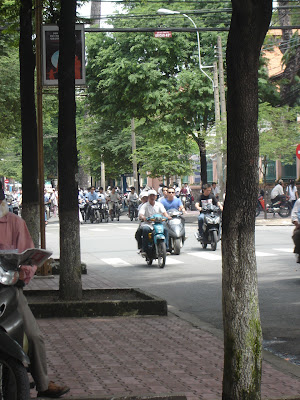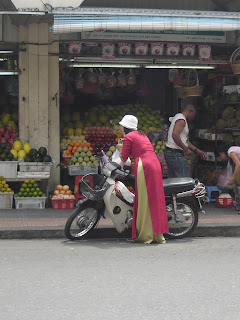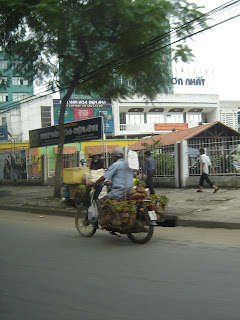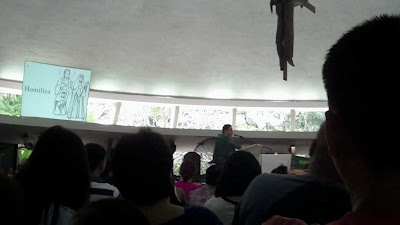[Blogger's Note: The President's speechwriter's twisted twits prompted me to post this story I wrote for BusinessMirror newspaper in October 21, 2007. It's about another city in Vietnam, which I visited when I was 38, but hope gives an overview of why wine and how men look piqued the speechwriter's interest rather than a country's rich culture.]
.jpg) |
Vietnameses' daily life is never without motorcycles,
which they use to go around Ho Chi Minh City
as well as transport or sell products.
Photo by Dennis D. Estopace
|
HO CHI MINH CITY – Some Asian destinations offer no pretensions. This city is one of them.
Vietnam’s urban center, named honoring its communist leader, allows guests to seep into its transformation from a war-ravaged capital to a place where one can escape the trappings of bourgeoisie pettiness.
From the airplane’s nose dive to slice through white mist toward Tan Son Nhut International Airport to the bustling city streets, the tempo of changes clutching its ten million people is at once felt.
The whole city itself is hot, literally, with high humidity and temperatures hitting above 30. Figuratively, there’s the prominence of red and gold colors in almost every mid-rise building lining the road from the airport.
The airport itself is undergoing transformation to the chagrin of Filipino workers and tourists that pine for the opening of Terminal 3. Tan Son Nhut is a notch above the Philippines’s old international airport in the sense that is has horizontal escalators or “walk-alators,” says one Pinoy working for an oil exploration project here.
Airlines staff said Tan Son Nhut airport, which is undergoing renovation and expansion, would become wi-fi ready in the next three months. Hence, they are preparing a new computer system for check-in and boarding. PAL staff were flown here to train Vietnamese on the new system.
Outside, the whole city is pulsing with life. Just sit and sip one of the many home brewed coffee at several cafés dotting the road to feel its beat. Everywhere, and at any time of the day, two-wheel vehicles like scooters, bicycles, and motorcycles carom here and there on the streets. It seems every Vietnamese –whether in jeans, mini-skirts, and the traditional cheongsam– has somewhere to go to and things to do.
Most of the restaurants here offer a view of the road so guests can ponder the symmetry that weaves these vehicles.
Even steel rickshaw driver Tung couldn’t explain why there’re few if no motor vehicle accidents in the city.
One reason could be the language barrier. Most Vietnamese speak French as second language. In halting English, Tung says the Vietnamese know how to move quickly.
.jpg) |
A Vietnamese woman in traditional Vietnamese garb
prepares to ride her motorbike
after buying fruits and flowers at Ben Thahn Market.
Photo by Dennis D. Estopace |
“We survived American bombs; we survive driving,” the 40-year-old Tung says in front of Ben Thanh Market where he and other drivers of a rickshaw –a two-wheeled bucket seat welded in front of a bicycle– offer one-hour city tours for US$15 (VND242,460 at US$1=VND16,164).
Ben Thanh Market, to note, is one of the reasons why Ho Chi Minh is a must destination for shoppers.
Located on District 1 and a five-minute walk from Caravelle Hotel where Hewlett-Packard Co. billeted Asian journalists, Ben Thanh is the most central of Ho Chi Minh City's many huge indoor markets.
From the entrance across a horse-riding monument of Ho Chi Minh, the market is organized according to rows of products. The first street block-long stalls sell garments and textiles, the second row offer lacquerwares and handicrafts, then dried and cooked food, fruits, and flowers.
An hour before it closes at 6:30 p.m. (7:30 p.m. in the Philippines), Ben Thahn remains packed with shoppers walking sideways along the aisles between stalls. The scent of linseed oil and dried shrimp mixes with human sweat and a bargain hunt, replacing the familiar smell of cordite and sulfur four decades ago.
Indeed, Ben Thanh is a utopia for shoppers not only because they could become instant millionaires for US$100 (VND1.6 million) but also because product prices could be haggled lower. A t-shirt hand-embroidered with Ho Chi Minh’s face could go for US$2.47 from the initial price of US$3.10 (VND50,000).
“What’s your price,” a vendor would say if a potential buyer asks then tries to move away. The negotiations go on until each reach their comfort zones. It’s best to go first to Ben Thahn just for a look-see and return for the actual purchase.
Fellow journalist Racquel devised an alternative to the must-carry calculator: a piece of paper. There she wrote tiered exchange rates, as in VND16,000= US$1=P44; VND65,000=US$4=P176; and, VND78,000=US$5=P220.
“The last one’s my pivot point,” Racquel said explaining that “anything higher than US$5 would be really spending.”
For the historian and the proletarian-spirited traveler, one notable must-go place here is the War Remnants Museum on Vo Van Tan Road. Opened to the public in 1975, the museum offers the reason what makes the Vietnamese tick. The eight permanent thematic exhibitions bare the numbing truth of the Vietnam War that began when the first American soldiers landed in Da Nang March 8, 1965.
Museum collections offer an in-your-face look at war: from methods of torture to the effects of 44 million liters of Agent Orange through photographs by 134 journalists, through sculptures, and actual ordinance.
.jpg) |
| A foreign tourist walks toward one of the cannons used by the Americans during their failed attempt to subjugate Vietnam and now is one of the collections at War Remnants Museum. Photo by Dennis D. Estopace |
An empty stomach and open mind could help visitors suck in everything the museum offers. It is advisable to go to here before visiting the Co Chin Tunnels to experience how the Vietnamese survived the 14 million tons of explosives dropped from B-52 bombers during the war.
If you’re as slender or thin as the Vietnamese, drop into the pitch-dark tunnel some of which lead to several rooms underground where they cooked, slept, and kept as silent as moles during the war.
Above, travelers could fire an AK-47, the most powerful assault rifle invented by man and widely used by Vietnamese guerillas, for 250 dong (US$0.25) per bullet. Don’t bother hiding the bullet shell as souvenir; the tour guides would know how many are missing.
Packaged tours to the tunnels and the museum, excluding entrance fees, begin at US$4 per person (US$1=16,164 dong).
A two-day stay in this city is worth more for these reasons alone.
As the orange sky glows, the Asian visitor to these places could begin to dig deeper in his or her heart the pride of being non-Caucasian, living simply and loving a country.
This makes one wonder why so-called Filipino revolutionaries noisily promising to drive out the “white devils” –as Tung calls Americans– in Philippine political-economy passed off the warmth of Vietnam as refuge, opting for the stark cold weather of the The Netherlands.
SIDEBAR:
How to go there: via PAL, which now flies daily, and Cebu Pacific, four times a week.
Where to stay: Caravelle Hotel is where 100 journalists from Asia-Pacific region were billeted. Located on Lam Son Square, District 1, Caravelle’s rooms begin at US$250 a night. Stay at the topmost floor (24th, smoking) to get a great view of the city. District 1, to note, is considered the commercial and business district with high-end stores like Dolce Gabanna and Louis Vuitton operating side by side local-brand shops.
.jpg) |
Motorcycles form part of the Vietnamese’s daily life.
Photo by Dennis D. Estopace. |
Where to eat: Lemon Grass, a block across Caravelle, is a four-storey restaurant offering mild-Vietnamese food, which is light on the use of lemon grass, a staple in Vietnamese cuisine. Try the soft-shell crab and, of course, the spring rolls. In 2007, there were two branches of Jollibee, one of which is near the museum at Nguyen Thi Minh Khai road. Also, check out the Mandarin restaurant on Ngo Van Nam Street and their eight-meal course.
How to move around: Taxis of the sedan and off-road types could be easily flagged but know ahead how much the fare would cost since some drivers charge double than what the meter shows. From the Caravelle to Ben Thahn, for example, the five-minute ride’s just under VND17,000 or US$1. Better yet, walk.
What to carry: Umbrella or hat, for protection against the sun or rain; cash; camera; street map; and, high alertness, especially when crossing streets.




.jpg)
.jpg)
.jpg)
.jpg)